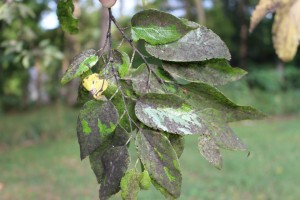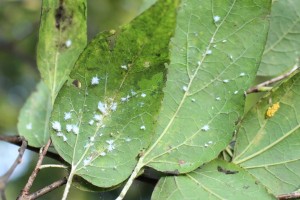
Sooty mildew on hackberry leaves (Photo courtesy of Dr. Alan Windham, UT Ext. Plant Pathologist, Nashville, TN
Aphids are small (1 to 10 mm long) and pear shape. Infestations are often worse during wet cool days of spring; they are frequently feed on new growing shoots and leaves. Actively growing weeds also harbor aphids and may migrate over to favorite garden plants. Summer feeding aphids should never be counted out. Feeding aphids may spread a number of bacterial and virus diseases from sickly to healthy plants.
Color varies by aphid species and are capable of changing their color. Common colors include green, dark pink, yellow, and black. Many are smooth and shiny, and a few are wooly or covered with fluff. Most aphids are wingless, but some may form wings a new aphid colony to find a new food source when plants they’re feeding on are in poor shape.
Aphids do not possess chewing mouthparts. They don’t nip chunks out of leaves or stems. Instead they have piercing or “stylet” mouthparts to draw out the sap from sugary phloem tissues. Plant damage shows up as leaf curling, stunted growth, yellowing (chlorotic), or any combination thereof.
Their reproduction rates are very rapid. Aphids can reproduce without mating. Aphids also molt 4 times before maturing as adults. The old flakey skins are frequently seen over leaf surfaces. A wet or sticky honeydew deposit builds up over leaves and stems; later, black mold fungus colonizes over leaf surfaces. The sooty appearance looks unattractive. The sooty mold may be partially hosed off.
Several pesticides are effective against aphids in a garden. Insecticidal soaps and oils kill aphids on contact. Systemic pesticides like neonicotinoids provide longer activity, but may harm many beneficial insects such as bees and butterflies. Products containing Beauveria bassiana, Azadirachtin (neem oil) and Endeavor (pymetrozine) control aphids without harming most beneficial insects.
The soft bodied aphids have numerous natural enemies including ladybugs, lacewings, fly larva, wasps, true bugs. Parasitic wasps may be purchased and released to reduce aphid populations.


 Posted in
Posted in 
